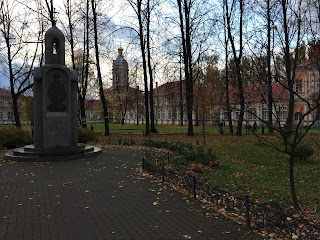149. Heading southeast on Nevsky Prospekt to Saint Alexander Nevsky Monastery
Nevsky Prospekt is St. Petersburg's main street in the city center. It runs for approximately five kilometers across the entire width of the main part of the Tsentralny District, in between a broad curve of the Neva River. I have walked back and forth on the western end of the street on almost a daily basis since I arrived in St. Petersburg - particularly the section in between the Fontanka River and the Griboyedov Canal. I've also frequently been to the western terminus, at the Palace Bridge in between the Winter Palace and the Admiralty building (headquarters for the Russian Navy). To the east of Rubinshteyna Ulitsa, I've occasionally walked four or five blocks, but not further east on Nevsky than Ploshchad Vosstaniya. There hasn't seemed to be much of a reason, with very few significant tourist destinations in that direction. Nevsky Prospekt continues southeast for a few more kilometers past Ploshchad Vosstaniya until it reaches the Neva River again.
There is one good reason to go to the eastern end of the avenue, though: the Saint Alexander Nevsky Monastery is located at the eastern end of Nevsky Prospekt. Both are named after Alexander Nevsky, a Grand Prince of Kievan Rus and the ruler of Russia in the thirteenth century. He won important military victories over German and Swedish armies, and was canonized in the 16th century in the Russian Orthodox church. He is considered to be one of the most important figures in Russian medieval history. The monastery here was established in his honor in 1710, and the cathedral church was built in 1790. The cathedral is an imposing presence. Like most active churches here, photography inside the building was prohibited, so I was not able to take a picture of the reliquary that allegedly contains the remains of Alexander Nevsky.
The extensive monastery buildings surround a large enclosed courtyard. Other than a small museum (the Museum of Urban Sculpture) and a cafe, the rest of the buildings are all used for official monastery business, and are therefore not open for curious tourists to explore. The museum contains various marble and bronze markers and an assortment of headstones. Some were from the several graveyards in the area and others appear to be taken from crypts or church floors. More interesting than this collection, however, are the thousands of graves still in situ in a large graveyard to the east of the cathedral and monastery.
There is one good reason to go to the eastern end of the avenue, though: the Saint Alexander Nevsky Monastery is located at the eastern end of Nevsky Prospekt. Both are named after Alexander Nevsky, a Grand Prince of Kievan Rus and the ruler of Russia in the thirteenth century. He won important military victories over German and Swedish armies, and was canonized in the 16th century in the Russian Orthodox church. He is considered to be one of the most important figures in Russian medieval history. The monastery here was established in his honor in 1710, and the cathedral church was built in 1790. The cathedral is an imposing presence. Like most active churches here, photography inside the building was prohibited, so I was not able to take a picture of the reliquary that allegedly contains the remains of Alexander Nevsky.
The extensive monastery buildings surround a large enclosed courtyard. Other than a small museum (the Museum of Urban Sculpture) and a cafe, the rest of the buildings are all used for official monastery business, and are therefore not open for curious tourists to explore. The museum contains various marble and bronze markers and an assortment of headstones. Some were from the several graveyards in the area and others appear to be taken from crypts or church floors. More interesting than this collection, however, are the thousands of graves still in situ in a large graveyard to the east of the cathedral and monastery.




























































Comments
Post a Comment